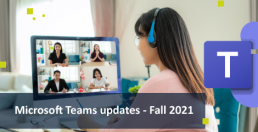“All you need to know about Microsoft direct routing” RBBN workshop, Dubai, March 23rd
We are always glad to participate in events together with our longstanding partner Ribbon Communications. This time it is an event organized by Ribbon in collaboration with Microsoft, and it will be on March, 23rd in Royal Meridien Beach Resort, Dubai. “All you need to know about Microsoft direct routing” is a one-day workshop reserved for RBNN network of partners and distributors and it will be focusing on Direct Routing deployment in Azure, with Ribbon’s SBCs and Mida integrated UC solutions for Microsoft Teams.
As you would imagine we've got a lot to cover, so let’s start telling you what you should expect from this in-person event!
What are the main topics of the event?
In this workshop, dedicated to Ribbon’s partners and distributors, they will be trained on key information they should know to efficiently propose and deploy Ribbon Direct Routing certified SBCs to companies willing to shift their entire communications in Teams. Johan Van Bruck and Rafael Vicent from Ribbon together with Eric Moneyang and Hikmat Tony El Ajaltouni from Microsoft will kick off with the presales session, including key aspects of the Microsoft Phone System and Ribbon SBCs suggestions and proof of concepts. Ribbon will train participants to deploy and install their SBCs on Azure and configure the process of Microsoft Direct Routing to easily connect the PSTN to the Microsoft tenant.
Mida’s Business Development Manager, Giovanni Nieddu will introduce to the attendees the Mida UC suite for Teams, which is interoperable with Ribbon’s series of SBCs certified for Direct Routing. He will explain the product architecture, the main features, and how to leverage the suite to manage the entire corporate communications, without regretting the advanced features of contact centers based on legacy technologies.
He will also highlight all the benefits of deploying Mida UC suite for Teams combined with Ribbon’s SBCs, both for distributors and for final users.
What does Mida’s offer comprehend and which are the advantages for companies?
Mida had already understood the enormous potential of Teams some years ago and, for this reason, designed a comprehensive set of UC solutions, including Contact Center, Attendant Console, Compliance Recorder, enabling enterprises to professionally manage and securely store all their business conversations in this platform. Moving the entire corporate communications in Microsoft Teams was made simple by this suite, which is easy to implement and install and guarantees a smooth user experience.
Adopting a professional contact center for Teams optimizes the interactions with callers, and can lead to improved service overall performances and consequently to greater customer satisfaction. Indeed, this solution adds to Teams standard native call management features, more sophisticated ones, which facilitate agents in their daily tasks. Advanced call distribution algorithms and the possibility to track all incoming calls (not only the ones that are handled by agents) are only some examples of the features operators can benefit from. Operators can also take advantage of the integration between Mida C3 - Cloud Contact Center for Teams and CRM tools such as Dynamics, Salesforce, to empower them with instant access to all the applications they use daily in a single platform.
Power BI integrated reports enable supervisors and managers to cross-reference UC data with any other business-critical data, directly in Power BI.
What are the benefits for Ribbon’s distributors?
Proposing Ribbon’s SBCs combined with Mida products for Teams release access to some advantages :
-
- These solutions are fully interoperable with Ribbon’s SBCs and Mida C3 - Cloud Contact Center is in the Microsoft certification program (it will be soon certified as a connected contact center). This means the products have passed some specific technical tests to ensure they efficiently work with Ribbon’s SBCs and they are compliant with Microsoft quality standards. So, distributors can propose them as a joint proposition characterized by the quality, compatibility, and reliability companies expect from a Microsoft solution. This will make the final customer more confident in the decision phase.
- Mida’s products are included in Ribbon’s price list. This allows companies to buy a certified SBC and a UC solution for Teams in a one-shop purchase. From the sales perspective, this is a huge advantage for distributors, as it facilitates their sales proposals to customers.
- Contact center, Attendant Console and Recorder for Teams are just part of Mida suite of UC applications. Ribbon partners can easily cross-selling other key UC applications, such as Call Analytics, FAX Server, Automated Attendant (IVR).
Are you part of Ribbon network of partners and distributors? We will be happy to meet you in Dubai, click here to register for the event!
If you don’t belong to this category, but you would like to know more about Mida-Ribbon joint UC proposition for Teams, do not hesitate to contact us at marketing@midasolutions.com.
Enterprise Connect 2022: a preview of our hybrid booth
It seems like this year we are going to make it! After 3 postponed editions due to Pandemic restrictions, we are excited to announce our team will be at Enterprise Connect, at Gaylord Palms Resort & Convention Center, in Orlando, Florida, to welcome EC visitors, old acquaintances, and partners.
SAVE THE DATE: March, 21th-24th
We will be at booth #437 to present our latest UC products for MS Teams and Zoom and explain to visitors all their features and the advantages for SMBs and large enterprises as well. For those who will not be able to join us in Florida, there will be the opportunity to connect online in our online booth!!
Why attend Enterprise Connect?
Enterprise Connect is one of the most globally popular events in the UC field: it is an IT conference and expo that gathers global companies, UC experts, and service providers putting on the discussion table the new communication and collaborations challenges and trends.
This year Enterprise Connect doubles: as anticipated, this edition will be in-person and virtual. If you’re asking yourself what does it means and what are the benefits of this 2022 edition, here’s a summary:
- IN-PERSON EVENT - As in all traditional events, the plus is that you will be able to shake hands (or elbow bumping) with persons, or make new connections with industry professionals who can give you relevant food for thought to get the most from new Unified Communications technologies. Either if you are in the process of scouting for a new UC product for your business, or if you are just snooping around to find out what the trends are, at EC2022 you will be able to find what you are looking for!
- VIRTUAL EVENT - After logging in here (link) you will access the event virtual platform from which you can download exhibitors’ products documentations, watch their presentation videos, and chat with their experts. This is an alternative way to know more about the exhibiting companies and their offers by getting in touch with them comfortably from where you are working. The virtual pass of course gives access to the in-site speaking sessions, which helps the experience to be more realistic, though still virtual.
- MORE ACTIVITIES PLANNED - During those days you can virtually attend 60 minutes webinars and follow online and in-person conferences on these topics:
- Contact Center & Customer Experience
- Video Collaboration & A/V
- Collaboration Platforms
- Practical AI
- CPaaS & Communications APIs
- Unified Communications & UCaaS
- Workplace Strategies
- Management & Networks
- Security & Compliance
The complete agenda of the sessions has already been shared in the event official webpage to allow visitors to define their personal agenda, plan commitments, and choose the must-visit booths.
What to expect from Mida?
Enterprise Connect is a great opportunity also for us to present to the United States audience our UC products, especially the new ones we have recently been unveiled. Mainly, we will present:
- a new UC suite for Zoom that allows companies to transform it into a unique hub for the entire business communications;
- a professional suite for Microsoft Teams, deeply integrated into the latter, thanks to the Attendant Console Teams App. Moreover, the integration with Salesforce and Dynamics is a plus that helps operators, to promptly manage informations interactions directly in the corporate CRM.this communication and collaboration platform.
- a new advanced UC analytics reporting solution integrated with Power BI and Excel. Call Analytics -that’s the name of the product - helps enterprises analyze UC data, unveiling weaknesses and unexplored potentialities and consequently allowing them to plan strategic actions, supported by data, to improve their services. This application is compatible both with Mida suite for MS Teams and Mida suite for Zoom.
Choose where to meet us, in-person or virtually: our team will be available both in the venue and online to welcome you at our best and provide you the answers you need.
Have we convinced you to attend Enterprise Connect? Catch this great networking opportunity and register immediately here for this four-day event. Enterprise Connect is less than 2 weeks away!
Mida and Microsys: together on Teams CRM integration
Our partner network is constantly widening and we are glad to rely on trusted partners around the world to help global companies get the most from UC technologies. Now we are glad to officially present our new business partner Microsys, an Italian System Integrator with which we partnered to provide our common customers with a complete contact center for Microsoft Teams integrated with Dynamics 365.
Who is Microsys?
Microsys is a System Integrator that for over 30 years, thanks to Microsoft technology, has been helping companies of all sizes take on the challenges of digital innovation effectively.
With more than 300 customers throughout Italy, Microsys supports entrepreneurs and managers to increase business productivity, improve data analysis and interpretation, adapt and use vertical ERP and CRM solutions and fine-tune the technological infrastructure for maximum efficiency and security in response to business needs.
Why did Mida and Microsys start to partner?
Some years ago we decided to put together our expertise to come up with the useful integration between our UC suite for Microsoft Teams and Dynamics 365 CRM to provide contact center agents with an integrated application, helping them be more effective in their daily activities.
We both understood how relevant it is for agents to have all the information at hand during conversations and that’s why we combined our different skills to provide a powerful solution that helps companies increase their customer service quality. For us, this common value proposition highlights a win-win relationship because Mida was searching for a Microsoft partner with Dynamics 365 expertise, and Microsys was looping up for an independent software vendor with innovative UC solutions for Microsoft Teams to complete its offering.
“Often many companies, which contact us to adopt Dynamics as CRM, ask us also for an integrated attendant console solution for Microsoft Teams. Now, thanks to this partnership, we have a joint solution that combines the professional features of a corporate contact center in a unique hub”, says Gianpaolo Vittorelli, the CEO and CTO of Microsys, explaining that being able to efficiently handle conversations in this way, is a crucial aspect for companies because it increases their service overall performances.
With this new powerful integration, when someone calls the company, immediately a Dynamics pop-up window showing the record of the caller appears: this makes both agents’ and customers’ experience better because the first is immediately aware of the scenario, without wasting time copying and pasting the caller number in the CRM to access records, and the second has a better perception of the service.
“Agents can make the same action manually but, with this integration, the service will be more efficient: it allows companies to provide a higher quality customer service and consequently enhance reputation. This does not concern only the big companies which have a high volume of calls to be handled but also the smallest.”, explains Marco Cortese, President at Mida Solutions.
“It’s simple and it works, this is the solution we thought for our customers and we are happy to provide it thanks to this partnership”, says Gianpaolo Vittorelli during a recent interview with Marco Cortese. They also anticipated that they are considering common future steps in this direction: provide an outbound product with the same integration.
For any questions about this joint solution contact us from this page.
Mida Call Analytics: your new advanced tool for UC reporting
Are we really aware of how crucial it is for companies to analyze Unified Communication data? This data hides essential information for your business growth: constantly analyzing your communications data enables you to understand your service weaknesses and turn them into opportunities.
This is what we focused on when we started developing Mida new reporting application Mida Call Analytics, officially released in Q1 2022.
Mida Call Analytics is much more than the basic reporting systems you may have used: we understood that this type of tool is not sufficient to provide enterprises with actionable insights they can use to optimize their business processes. For this reason, last month Mida added to its portfolio a new comprehensive and professional business reporting solution which makes it easier for companies to understand what information is hidden behind their UC data. We, therefore, decided to abandon the UC basic reports - as they were conceived in the past reporting application- to exploit Business Intelligence technologies to design a new top-quality reporting tool which enables to elaborate data in many different graphical forms and to integrate them with any other business-related data.
“Given the essential role that data analysis plays in business growth, we chose to design a solution integrated with Microsoft Business Intelligence platform (Power BI). It is compatible with legacy PBXs, Microsoft Teams and Zoom environments to enable as many companies as possible to harness the power of this new tool to grow..”, says Attilio Licciardello, CFO at Mida Solutions, “Our solution is designed to be flexible: according to which type of data you need to analyze, you can choose between three different sets of reports, available in CSV or PBIT for Power BI, that gives you the possibility to extract important information about your UC.”
Mida Call Analytics is based on three different modules:
- ENTERPRISE ACCOUNTING MODULE: this module helps you to analyze business processes, the phone traffic divided per cost center, the cost attribution, be aware of the value of your conversations, verify the real use of telephone infrastructure (also with multi-tagging) by aggregating data services not only for geographical criteria.
- CONTACT CENTER MODULE: this module allows you to improve both the service (e.g. by knowing for example how it is performing, if there are some weaknesses, verifying compliance with SLAs, and monitoring improvements...) and agents' performances (e.g. analyzing their KPIs, knowing if they need extra training or if the size of the team is adequate to manage for example peak loads).
- COMPLIANCE RECORDING MODULE: this module easily provides customers with key information on their recorded conversations, helping verify and track that recordings are in compliance with the latest privacy and security regulations. Another important aspect of this module is the “call match” function: this feature basically verifies that the number of calls that have transited through the PBX are equal to the number of recorded calls. This element is helpful to identify if and when there are errors in the call recording system. This check is essential for compliance purposes and ensures that the company is effectively complying with the relevant legislation.
As anticipated, for each module, Mida provides a set of ready-to-use template reports containing all the standard and most important KPIs.
One of the great innovations of this new product is the possibility to obtain almost infinite types of other reports:if you feel the template reports provided are not enough for your analysis you have the possibility to create your own personalized reports based on the direct access to the database. With specific views based on the module you have chosen, you can create new types of reports, which complete your personal picture on your UC. From a business management perspective, it is helpful to identify critical points and unexploited potentialities of the service itself.
Mida provides all the documentation needed to read and analyze template reports, to know how to aggregate your UC data as efficiently as possible, and how to use database access to obtain your custom KPIs.
Do you want to go deeper into this product? Feel free to contact us by filling this form, we’re more than happy to answer all the questions you may have.
Mida Recorder new UI: simple and intuitive
Mida never stops updating its UC products, and it’s not just a matter of technologies, security, features, integrations and compatibility with 3rd party applications: we take also user experience very seriously, and this is exactly what the latest Mida Recorder update focuses on.
Mida started the process to improve the UI and UX of its suite of UC products some years ago with the new look and feel of Mida Attendant Console and now we continue the update with a new version of the recording application, which recalls the same graphic principles used in the previous product. This is because we want to guarantee graphical continuity to our customers: it is not uncommon that the same company uses more than one of our products, so we have tried to keep the graphic updates consistent with the same style. This makes it easier for non-expert users to use a new application if they are accustomed to using other Mida products.
A software product with a simple and essential interface helps users carry out their daily tasks by reducing the time that would physiologically have to be devoted to learning how to use the application. Our philosophy is “what you are looking for must be at your fingertips within a click” and this is what kicked off this renewal project.
The application from which you can listen, compare and perform advanced searches among the recordings captured by Mida Recorder is now available in a new web-portal, called the “Playback Station”. It is accessible by authorized users through secure login via several web browsers, including Chromium. Before this release, recorded calls were visible in Mida Unified Portal (MUP), the web-interface from which Mida customers and partners perform administration and configuration activities regarding Mida products.
The decision to give the Playback Station a separate and independent identity makes it easier for users to search and retrieve recorded calls, quickly listen to them or compare audio files at the same time with a multi-track player. Security of files is granted thanks to encryption and anti-tampering signature, while storage optimization is available if necessary: compressed files can be stored either in Cloud or on-Premises.
“We designed the new Playback Station in order to help users find files in the shortest possible time and easily reconstruct conversation scenarios. We provide a new waveform that enables users to rapidly understand if there has actually been some speech in the call or only silence has been recorded”, explained Giulio Biondo, our Research and Development Manager.
The new interface is orderly organized in specific areas: in the main page, there are the lists of recorded calls, the basic research areas, the advanced searching options based on advanced call metadata and specific fields (the system allows the user to add notes and tags to calls and also mark them as important).
In order to limit the amount of call information that will be retrieved, users can select the time interval and configure their platform through the settings available directly in the Playback Station (e.g changing the columns shown in the main page).
To go deeper into the new UX and discover the new features of this video and voice recorder, feel free to contact us here for any questions. We will deal with your request in a flash!
Call Recording: the 6 main benefits for your customer service
Call recording softwares are an important tool companies can rely on as they can often be integrated into cloud-based contact centers, ensuring that each conversation with customers complies with internal privacy regulations and/or corporate regulations. In addition to the compliance aspect, recording softwares can be used also for training purposes, playing a leading role in improving the customers’ experience with the company services provided by the call center.
Do you know the benefits of this UC product?
Let’s analyze together call recording advantages.
What is call recording?
A recorder is a software that allows the capture of voice and, in some cases, also video communications using VoIP. Which conversations have to be recorded can be set according to the needs: total recording records all conversations, selective recording captures just the types of conversations identified by administrators, on-demand recording allows operators to manually start the recording when needed.
Recorded files can be digitally encrypted for security reasons, and the storage repository may differ according to the type of recording software you are using.
The recording software can be integrated into an existing contact center or it can be available as a stand-alone application (as said before, for example, for compliance reasons).
Why is call recording so important for your business?
In some environments, companies are required to record calls for data protection and compliance purposes, but recording calls is important also for other businesses as they can all benefit from it. Why and how? Let’s analyze together how call recording can help you to enhance your customer service and grow your business, beyond being indispensable for compliance purposes:
- Improve customer service - Everybody knows the more your customers are happy with your customer service, the more likely they are to buy again from you. After being satisfied with the service, which quickly resolved their request, 50% of customers say that they would pay more for the product/service you offer (Hubspot 2021 customer service report). This important data confirms the relevance of good customer service in purchasing decisions and customers’ behaviors. The experience people have with your company impacts on the perception they have of your brand and on their purchase intention so it is good practice to analyze operators' conversations to find out whether they have handled requests satisfactorily. By analyzing these files you can understand if something goes wrong during calls and measure customers’ sentiment to discover also what they think about your brand and/or your products. For example, by listening to calls you can find out the reason why some calls are interrupted prematurely and how to prevent it. You can then plan strategic actions (e.g. establishing guidelines for the management of frequent problems).
- Understand weaknesses and strengths of your service and products - By listening to call recordings, you can identify which aspects of your service are strong, and which can be improved. By listening again to conversations you can also collect product feedback directly from your customers, even discovering suggestions that no one in the company had thought of before. This is an excellent opportunity to take the customer's point of view and use it to make sure that you are a winner over your competitors.
73% of people stay loyal to a brand if their customer service department is friendly with them and 54% of customers have high expectations of it (2021 Hubspot report).
- Know better your customer needs, preferences and behaviors - Listening to recorded calls allows your marketing team to know your customer base better by collecting some essential information such as common requests and needs. People feel less frustrated during calls if they perceive you know them well and you understand their needs. 72% of customers admit that they expect customer service to meet their needs and consider them as unique individuals (Hubspot 2021 customer service report) with personalized support.
- Increase customer satisfaction - This aspect is strictly connected with the previous one because when you know your customers you can exceed their expectations by providing an experience that goes beyond what they consider 'satisfactory', as shown before. For example, you could quickly solve his issues at the first call and make him satisfied with your good treatment if you know better his purchases, needs and requests. He will be happier!
When agents are required to take hundreds of calls a day, it is understandable that they do not always manage to take note of all the information. A recording system also allows agents, according to permissions that are configurable by the system administrators, to retrieve past calls to listen to them again and clarify any doubts. As a consumer, you know how unnerving it is when you have to contact customer service more than once, just because operators didn’t take note of information properly. On the other hand, this is also a great opportunity to be proactive in the following calls as agents can plan personalized follow-up by exploiting information obtained from the re-listening of conversations.
- Motivate your agents to increase their performance - Although it is quite disheartening to say, some people are at their best when they know they are 'under observation'. Knowing that they are being monitored can encourage operators to be more proactive, polite, and effective in successfully resolving the call. Moreover, recording analysis can be used for annual performance review and analysis: agents’ activities can be monitored using call recordings to be evaluated for performance-based awards.
- Coach your team and identify new ways to serve customers - Listening to call recordings you can identify best practices and worst practices in how agents guide the conversations. You can use these files with newcomers or employees for training purposes. Thanks to recordings you can analyse the performance of agents not in real-time to give them feedback and suggestions to provide a better service. This could be a win-win practice: agents will feel supported and motivated in their role and you will find -together with them- new ways to help customers. And your business will take advantage of it!
To know more about Mida recording software and go deeper into the adoption of a recorder contact us here. We would love to play a role in your new customer service!
Another big milestone achieved: Mida UC suite for Zoom
Mida UC portfolio is getting more and more enriched with new solutions: we are happy to announce that recently we have included in our offering contact center, attendant console, and compliance recorder for Zoom.
Since the second half of this year, we have seen a fast-growing interest in UC applications for Zoom, so we decided to work with Zoom engineers to integrate our technology with this platform, to provide Zoom business users with professional Unified Communications applications. Let’s go deeper into this news!
Zoom growing adoption
Thanks to its reliability and its intuitive user interface, Zoom adoption has grown exponentially in the last couple of years. It was the preferred communications and collaboration tool chosen especially by certain industries, like private enterprises, public sectors, and education, to overcome the problem of social distance during the Pandemic. Companies and schools quickly reimagined their daily tasks and moved all their interactions in the digital environment to easily connect people.
This year Zoom commissioned the Boston Consulting Group (BCG) to conduct a survey, which highlighted some key data regarding the future of business communications:
- 84% of the technology businesses interviewed say that “video conferencing solutions will continue to be essential for business operations beyond the pandemic”
- Among all the businesses surveyed, they expect over a third of employees to work remotely beyond the pandemic.
Mida new UC suite for Zoom
In spring 2021, also on the basis of inbound requests, we started scouting the technology approaches that could allow us to create a complete suite of UC solutions for Zoom… We are now happy to publicly say that we have enabled the usage of our contact center, attendant console, and recorder to enterprises using Zoom Phone as a communication platform. These new products are now available on a single virtual machine to ensure high-quality communication management. Mida C3 Cloud Contact Center was created to be a multi-user and multi-tenant platform ideal for service providers.
“Our mission is to provide enterprises with professional and complete UC applications, no matter the environment they are based in. Therefore the inclusion of Zoom suite in our portfolio is the natural consequence of the changes that have taken place in the communications industry over the last two years. This is certainly a project that we will continue in 2022, in direct collaboration with Zoom, so I look forward to sharing the next steps”, said Serena Rigato, Marketing Manager at Mida Solutions.
What can you rely on?
Getting better business productivity and enhancing customer service by having all your interactions, such as chat, virtual meetings, and call management, in Zoom is now possible!. Thanks to our new UC suite you can get the most from your UC by adding to Zoom basic call treatment capabilities Mida professional features, such as:
- customizable routing algorithms (e.g. skill-based, round-robin, idle-time),
- customizable IVR systems, advanced real-time and historical reports integrated with Excel and Power BI,
- integration with the main CRM platform (Salesforce, Dynamics),
- compression and encryption of recorded conversations,
- the intuitive Playback station, from which you can instantly retrieve, play or download files
Mida suite for Zoom will add greater flexibility to the customer service managed via Zoom Phone, allowing supervisors to:
- configure different services and for each queue
- assign agents to multiple queues
- define the most appropriate call treatment messages,
- easily change holidays messages, working hours,
- instantly and selectively define after call work for each queue or agent
and gaining more freedom for operators to be effective in managing their workflow, thanks to the possibility - for example- to selectively login and log out from the queues they are assigned to, or to set manually their availability status.
This is all for now, but if you want to discover more about these products please visit our Zoom dedicated page, or contact us directly by filling this form.
New Year, New Plans: Preview from UC Summit 2022
Mida will be among the sponsors of UC Summit, the UC Today’s annual conference and expo about Unified Communication and Collaboration latest news.
This virtual edition will be running between the 24th and 29th of January. Save the date on your agenda!
Why should you attend UC Summit 2022?
There are many reasons why you should attend this 5-day event:
- with free online registration, you can have access to exclusive sessions, speeches and insights to be updated on future UC scenarios;
- During these days you can visit the UC company's virtual booth, watch their experts being interviewed and download useful documentation.
- It could be helpful to understand what to expect from 2022 in terms of new UC applications. You will be able to make informed purchases or to drive your customers’ ones .
- UC Summit helps technology leaders to learn more about evolutions in the UC industry and know how to overcome new challenges. Industry experts will give a lot of food for thought to improve communication and collaboration.
What to expect from Mida?
UC Summit 2022 will be the occasion for us to unveil some brand new products and new features:
Mida UC Suite for Zoom
In response to the increasing popularity of Zoom, and the consequent growing demand from customers and partners, we have decided to make our most appreciated applications available also to companies willing to transfer their communications from legacy PBXs to Zoom Phone.
This new web-based and intuitive suite comprehends a complete contact center, an intuitive attendant console and a compliance recorder - all of them available in a single virtual machine.
The suite makes both agents’ and supervisors’ activities more efficient as it allows agents to promptly manage incoming calls, and it provides supervisors with advanced contact center functionalities and settings and key information on how the service and the agents are performing.
Compliance recording is included in the suite and is a powerful and professional recording application ensuring businesses to stay compliant with either privacy regulations and preferred internal call management protocols.
Mida Call Analytics
It is the latest addition to the Mida portfolio. Mida Call Analytics is a professional reporting system able to provide any insight a company needs to analyze its inbound call traffic. Moreover, the fact that this product produces reports that can be integrated with Power BI, combined with dedicated views on the database, allows companies to create their own custom reports, and then integrate insights with any business-related data.
The solution includes different modules, available as stand-alone products, and each of them comes with a set of template reports which collects the key data on contact center activities, enterprise accounting and compliance recording.
This call reporting and analytics tool is a must-have tool that helps businesses grow through actionable and integrated insights.
Are you thrilled to discover more about these products, or are you ready to discuss your project with us?
Click here to register for FREE to UC Summit 2022 and visit our virtual booth during the event to get the product documentation.
Contact us at marketing@midasolutions.com if you'd like to learn more.
Microsoft Teams updates - Fall 2021
Have you followed all the latest Microsoft Teams updates? If you feel you have missed something, don’t worry!
In this article, we have summarized the most important news, including the ones announced during the last Microsoft Ignite 2021, in November.
CHATS
- Delayed delivery - Soon you will be able to easily schedule messages to be sent when you prefer. This feature will be useful if you write a message and you want it to be delivered at a specific time.
- Enhanced research - Searching for information in Teams will be (finally- we were all looking forward to it!) faster. Thanks to new results filters and the possibility to toggle between tabs (messages, people, files), you will find what you need in a flash.
- Check people’s time zones - If you are used to collaborating with people based in a different time zone, being certain you are not messing up with meeting invites is not child’s play. The contact form will contain this information, helping you to optimize communication flow by decreasing response time.
- Chat with self - We know that chatting to yourself may sound strange, but it could be helpful. Soon in Teams, you can have this opportunity to have a secure private chat where you can save quick notes, drafts, ideas, and reminders.
WEBINARS AND MEETINGS
- Role assignation - When organizing a meeting, you will be able to assign people roles, such as presenters and co-organizers, and set who can change meeting options, create polls, and manage breakout rooms. This option can definitely improve the way you o manage online events in Teams.
- Hands-up order tracking - When presenting a webinar or during meetings, it isn’t so easy to understand in which order participants have raised their hand. To overcome this and avoid unpleasant situations, you can soon view the hands-up order to let attendees talk in the right sequence. Moderating Q&A sessions will be easier thanks to this option.
- Intelligent camera capture - Soon what you write on a physical whiteboard or documents can be captured by an intelligent camera and displayed on the screen as a high-quality image during meetings. This will be an interesting mix of the physical spaces and the virtual ones to increase engagement with, for example, hand-made graphics during a live event.
- New avatars experience - Hybrid work is a trend that is here to stay: people will continue to work from different places and for several reasons not everyone likes to turn on the camera during virtual meetings. Microsoft has introduced Mesh for MS Teams, bringing a new generation of 2D and 3D meeting experiences with personalized avatars and immersive spaces. This solution will use artificial intelligence to simulate facial expressions, eye contact, human gestures, achieving to maintain engagement and provide a sense of real presence during events. With Mesh for Microsoft Teams, in addition to this opportunity, you can create a new virtual space, resembling the physical ones, where avatars gather to collaborate and communicate feeling like they are in the same place in the physical world, like sharing documents and presentations on the same multimedia whiteboard in a meeting room .“We allow you to connect with presence and have a shared immersive experience directly in Teams”, said Satya Nadella, CEO at Microsoft.
- Virtual green room - You can soon create a virtual room in Teams, not accessible to the attendees, where event organizers and presenters can socialize and keep in touch before and during the event. This will improve collaboration and also the organization and management of live events in Teams.
- New attendees experience - While attendees wait for the event to start, it will be possible to set a welcome image and let them use the Q&A chat. Moderators can also review their questions before they are published and they will have the possibility to flag and pin the most relevant ones- together with their respective answers- in the Q&A space to make them more visible to attendees. This will avoid the repetition of similar questions during the event.
COLLABORATION
- Microsoft Loop - Working together will never be so easy: a new collaborative application will be available soon in Teams to help hybrid work models. This new feature will allow you to quickly create new workplaces with interactive widgets (e.g. tabs, notes, lists) and shared pages to collaborate simultaneously with other people, updating documents in real-time for all users across multiple applications. It will be easy to develop a joint project, with multiple apps data, and keep track of progress in a unique virtual space in Microsoft Teams.
- Teams Connect - This is going to become a new way to improve collaboration with people outside your company: you will have the capability to create a cross-company workplace to share files and channels with up to 50 teams, write documents, and chat also with people outside your organization.
What do you think about these new features? In the meantime stay updated by subscribing to our Newsletter here.
How to complete Microsoft Teams offer with enterprise telephony solution - webinar
Are you a service provider or a system integrator? What do you know about Direct Routing and contact center applications for Microsoft Teams? If you want to know more about this topic to help your customers choose the right UC solutions, you should save this date: 18th November 10 am CET. Patton Electronics will be hosting a webinar, in collaboration with us, where we will explain how enterprise telephony can be brought into Teams, thanks to Patton certified SBC combined with Mida products for Teams.
Mida and Patton partnership in a nutshell
In July 2021 we announced our partnership with Patton Electronics and the tested interoperability between our UC applications for Microsoft Teams and their SBCs certified for Direct Routing in Microsoft Teams (click here to read our article).
This partnership is a win-win collaboration which provides our joint customers with a complete and trusted offering for MS Teams, allowing them to move their communications in Teams without any thoughts, focusing only on the operational aspects. The testing phase Patton and Mida completed a few months ago, has swept away any technical complexity, making adoption and configuration much easier for IT Managers.
“The partnership with Patton is part of a wide-ranging project: we have invested a lot of resources over the last few years to integrate the Mida for MS Teams suite with a wide range of certified SBCs. This is because we think it is essential that customers can keep their trusted suppliers, if that is feasible,” said Marco Cortese, our President. “Patton is an international company and we are therefore proud to be able to offer their customers the possibility of using Mida contact centers, attendant consoles and recorder in MS Teams.”
Why you should attend this webinar
Patton and Mida during this one-hour webinar will explain why our UC solution for Microsoft Teams, together with their SBC offering, are the perfect mix for your corporate communications in Teams.
We will show participants how Patton certified SBC can securely enable the connection to the PSTN, how our professional voice applications for Teams (contact center, attendant console and recorder) integrate in the new telephony architecture, and the consequent advantages for both the final users and their Managers. We will show in detail what the tangible benefits of adopting Teams as a single hub are, and how to leverage the suite to manage the entire corporate communications.,
Don’t miss the opportunity to participate in the live Q&A, share your thoughts and clarify any doubts you may have. You will have the chance to address them directly to Marco Cortese, Sales Manager and President at Mida Solutions, and Gilberto di Pietro, Regional Sales Director at Patton Electronics.
Please note that the event is reserved for service providers and system integrators!
If you belong to one category or the other, then get on board registering here to book your virtual seat.










